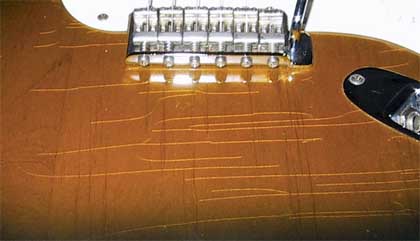« Top Picks reprise |
Main
| Chestnuts roasting on an open 5th. »
 December 18, 2014 | Snap, crackling, and/or pop. Cold weather shipping. December 18, 2014 | Snap, crackling, and/or pop. Cold weather shipping.
Winter has officially checked in at JazzMando Headquarters in the midwestern US and like every year, it's a sure thing to get worse. We hear of concerns of mandolin shippers and recipients (especially up through the great White North), and wish to extend a message of comfort and assurance. Music retailers and luthiers have been dealing with harsh inclement shipping weather for years. What do you think a music store does for income during the months of December, January, and February? They don't stop, but they certainly employ prudent procedure.
Understand, our admonition is for the geography of meteorological extremes. Those of you in San Diego or Hawaii who don't know what "real" weather is have little to be concerned about. Those in high elevations or parts of the country prone to occasional snow should still take note. There's no reason to not be careful. A few minutes of indiscretion can cause horrible damage to finish, and there's no sense in taking chances.

If you are planning on shipping an instrument (or receiving) in a harsh winter climate, there are simple precautions you must take to assure a safe journey. Wood and strings are remarkably resilient to extremes of temperature, but not quickly. In other words, your mandolin can survive quite well in subzero, but it won't tolerate a rapid transition back to room temperature.
Generally, if your instrument is packed well enough to endure the harshness of a Yuletide UPS Brown or FedEx Home temporarily, it's probably already got the cushion to make temperature changes of the journey slowly, but only if you allow enough time for that change upon arrival. We recommend anything received in temperatures below 30 degrees Fahrenheit (-1 C), allow 8 to 10 hours to acclimate before opening.. This means you let the package padding do the slow conversion for you. Don't unseal the box, certainly, don't cut a slit in the box to feel how cold it is. We've said 24 hours before and you'll hear that from music stores and builders for a very good reason. If they get their UPS by noon and close at 6:00 or 7:00, staff really should not unbox until the next day. Again, why not be safe?
You doctor may tell you not to stick anything in your ear smaller than your elbow. It's a bit of hyperbole, until you've met someone with Parkinson's Disease who punctured his ear drum with a Q-tip.
It's tough to not be cavalier about it, but if you do open the box, the finish and the wood acclimate at two different rates. That's where the infamous crackling or "checking" occurs. It's probably not so good on the joints either, but most of the irreparable damage will be the outside cosmetics. Do yourself a big favor and resist temptation to open a box prematurely.
Heads up, too. If you're shipping to someone in a cold region who has never received an instrument, it's on you to remind them about waiting. If you're offering a 48 hour right to return, we suggest extending that to 72. It's for your own protection, as well.
Suggestions for packing:
Never pack too tightly. Small air pockets allow not only a balance between moderate temperature "breathing" and stability, but act as shock absorbers during the rigors and stress of transport. Packing peanuts, bubble wrap, or loose newspaper balls will work, but find the balance between settling or nesting the instrument without complete stasis where all the box jarring is transferred from the outside to the instrument itself. Also, we suggest placing instrument and case in a tall kitchen trashbag prior of packing, partly because of sealing the air, but more because you'll keep the outside of the case lint and static free. It's a royal pain brushing off newspaper shreds or broken Styrofoam off of a mildly electrostatic-charged case exterior; this simple preventive measure introduces a simple cure.
Posted by Ted at December 18, 2014 6:56 PM

Disclaimer: In the 'Information Age' of the 21st Century,
any fool with a computer, a modem, and an idea can
become a self-professed 'expert." This site does not
come equipped with 'discernment.'
|



